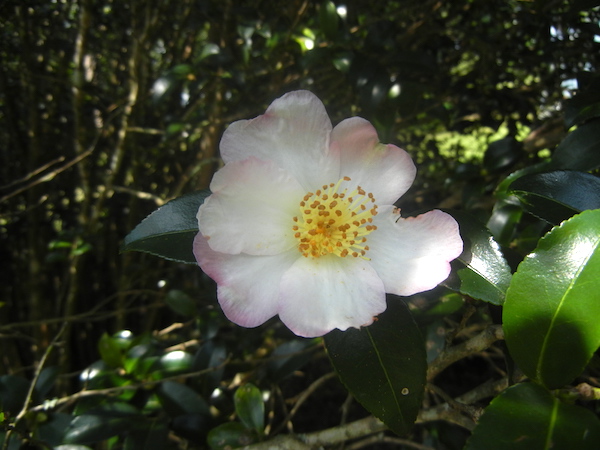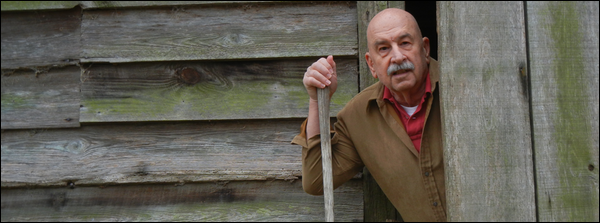The Queen of the Garden
“Thousands . . . . There was a time when my obsessive-compulsive impulses had me determined to get one of every kind; fortunately, my obsession expired before my financial resources.”—William A. Balk, Jr.
Epicurus’ Porch
By William A. Balk, Jr.

 ELKO South Carolina—(Weekly Hubris)—December 2017—The first of the cold snaps have come and gone and come again. They seem a little later than usual this year, finally bringing some of the rain we’ve been waiting for. The grey days and welcome downpours, though, yield to the now slanting rays of the autumn sun. Some days, the sky is filled with billows of white cloud, as if the ripening cotton fields have found a celestial mirror.
ELKO South Carolina—(Weekly Hubris)—December 2017—The first of the cold snaps have come and gone and come again. They seem a little later than usual this year, finally bringing some of the rain we’ve been waiting for. The grey days and welcome downpours, though, yield to the now slanting rays of the autumn sun. Some days, the sky is filled with billows of white cloud, as if the ripening cotton fields have found a celestial mirror.
As the sun’s path drops lower in the sky, the intensity of the light diminishes, the shorter days signal to plants that it’s time to store up reserves of food and energy. Sugars and carbohydrates in deciduous plants are transported from the canopy of leaves to stems, roots, bulbs, rhizomes—wherever that plant has managed to build storage organs. Deciduous trees and shrubs will lose their leaves once these carbs are drained away; at the base of each leaf, stronger cells repel a layer of weaker cells, creating an “abscission zone,” almost pushing the leaf away when it is ready.
Here in the upper coastal plain of South Carolina, most years don’t produce a spectacular show of colorful fall foliage. We do have some reliable trees in our woodlands, trees which defy the expected muddy tones of a deep south autumn. Hickory (Carya sp.) generally makes for a bright golden crown, a color which also appears along streets in our towns and cities where thoughtful planners long ago planted the glorious gingko tree (G. biloba). Sweet gum (Liquidamber styracifoia), which may just be the loveliest Latin name for any plant!) is in almost all the woods, brilliant in its simultaneous shadings of green and yellow, red and purple. Its color and its leaf shape could make sweet gum a suitable replacement for the brilliant maples of the north but, even here in the warm south, we have our own native maple species—perhaps most common, the swamp maple (Acer rubrum). Its red fall coloring gives that tree its name.
There are others, too. The tupelo tree (Nyssa sylvatica) is also called black gum in this area and, despite that name, it’s a particularly colorful dark-red-to-purple presence in the forests and in many a landscape. Beech trees will turn a dusky yellow and quickly veer toward tan coloration, surprisingly lovely with the elegant form of the long-lasting leaf and the tree itself. Home landscapes and city plantings often utilize the beautiful crepe myrtle (Lagerstroemia sp.), almost always planted for its great colorful summer panicles of red or pink or lavender or white. Some species and some hybrids, however, can be fully as brilliant in the fall, when the small, delicate leaves may turn hot red and pink and yellow.

As the autumn leaf show fades, as the leaves of deciduous trees fall, the real treasures of our woodlands and home landscapes get to display their rich emerald winter cloaks. These southern woods are dominated by broad-leafed evergreens, so different from the needled conifers of more northerly forests. To be sure, great acreage is allotted to monoculture plantations of loblolly pines, but the natural lowland forests of the coastal plain are filled with dozens of species of flat, broad leaves, each in its own shade of green.
In our woods, there are hundreds of the great southern magnolia (Magnolia grandiflora), sometimes accompanied by the threatened and uncommon red bay (Persea borbonia). The Carolina laurel cherry (Prunus caroliniana) keeps most of its leaves to provide a dense green cover for nesting birds, while the great live oak (Quercus virginiana) has a variety of live-oak species, each adapted to slightly different circumstances, from salty marine winds to freshwater wetlands to dry sand hills, all green the year round.
Hollies are native to our woodlands, too, and there are several species which predominate in our woodlands. The classic American holly (Ilex opaca), tall and full and red with berries until the birds have their fill, thrives throughout the mixed forest, in numbers even greater than the magnolias. Two smaller hollies, yaupon (Ilex vomitoria), and cassina, or dahoon (Ilex cassine), played important roles in the daily lives of the indigenous peoples who held these lands before Europeans arrived. These hollies, too, have handsome red berries each winter, along with tiny grey-green foliage as background.
Many gardens will have a single specimen of weeping yaupon holly, faithfully bearing huge quantities of berries each winter. This may seem an anomaly, since a single plant of holly is either a pollen-producing male or a berry-producing female plant. If only one plant is there, how can it bear fertilized berries?
Of course, the presence of wild yaupon holly plants in the woodlands is the answer; bees and other pollinating insects will carry pollen from a male tree in the woods to the lone domesticated female in the yard, and the spectacular show of berries results, even without an obvious partner nearby.
These broad-leafed evergreens of our forests and our landscapes, however, assume a lesser significance for me this time of year, for everywhere the queen of the southern landscape is coming into its own.
I should be honest, I suppose, and acknowledge that my love affair with the genus Camellia is not restricted to its autumnal start of a long six-to-eight-month period of bloom. I admire and praise this wonderful tree. Younger gardens, of course, get to experience camellias only as shrubs; however, given decades to grow and prosper, these magnificent plants can attain admirable height and spread. Throughout the year, a camellia tree’s green glory—in healthy specimens, usually a rich dark green—makes for an imposing presence in any landscape, requiring no eruption of efflorescence to establish its dramatic function among the plantings.

Camellias are native to southeast Asia, and their natural range extends from cool piedmont regions, through temperate valleys and plains, and into subtropical and even tropical regions, so long as alkaline soil conditions are avoided and extremes of sun exposure are guarded against. These conditions are matched in a number of other regions in the world, which has resulted in camellias becoming established in many temperate regions worldwide.
Fortunately for me, this region of the American southeast is perfectly suited for several species of Camellia; they grow well here in the upper coastal plain of South Carolina, with our acidic soils and established tree cover to ease the intensity of our harsh sunlight. It seems that our camellias have little difficulty establishing themselves beneath the great oaks and pecans, even though the root systems of those old trees are dense and cover hundreds of square feet.
The oldest camellias on the old farm, planted probably some 75 to a hundred years ago, are two simple old-fashioned sasanquas—one, a single in a light pink, and the other, a single white flower with pink blotches on the ends of the petals. Most of the year, these old plants are that rich dark green on small waxy leaves. We have grown them as huge shrubs, with dozens of stems growing up and out from near the base, even though they are the size of small trees. They are some 18 feet high and are easily 20 feet in breadth. Each is an eye-catching sight on the lawn, doubly so once the September bloom begins.
The sasanquas are fall-blooming, and their bloom season lasts from September into December. The dark leaves of the plant provide a superb backdrop for the many hundreds of flowers which cover the tree during the fall. The vigor of their bloom is matched by a surprisingly fast growth rate. When the old sasanqua in the back yard was getting so tall that it was growing into the power line above, my father completely coppiced it, cutting its bare trunk to only a foot or so above the ground. (I should note here that the trunk of this old Camellia was more than a foot across). That Camellia is now larger than it was when he cut it down; the power line has been moved.
Many hybrids of species of Camellia sansanqua and other species of Camellia have been developed, and these have produced a huge range of color and form, the very fragile substance of the sasanqua flower has been strengthened and improved, multiple layers of petals have been encouraged, and even scent has been developed in some types.

Long before these fall-blooming sasanquas finish their bloom in December, the Camellia japonica bushes have already begun their extended bloom season. These will bloom all through the freezes of January and February, blooms turning brown and falling off when the temperature drops below 30 degrees F or so. But as soon as the temperature rises above freezing, the plants start blooming again. This bloom season will last until April—sometimes into May –
Camellias lend themselves to hybridization quite easily, and their genetic traits seem to be quite fluid, producing variations in leaf color, leaf shape, bloom form, bloom color, etc. with regularity. There are new variations popping up all the time, sometimes on the end of a single branch of a plant. Desirable ones may be propagated and new varieties which result may be offered to others.
Thus, there are foliage variants which offer leaves with a yellow edge; others have a yellow or white streak down the center of the leaf. Some have a leaf tip which is split, making a “fishtail” leaf. Some have a stem which veers off at an angle at each node, producing a zigzag stem.
And then there are the variations in the bloom. I can’t even begin to describe those—there are registered with the International Camellia Society thousands of named varieties. The number of unnamed, unregistered varieties is unimaginable. There was a time when my obsessive-compulsive impulses had me determined to get one of every kind; fortunately, my obsession expired before my financial resources.
I may have lost my obsessive need to acquire every camellia, but my deep attachment and powerful affection for the genus remains intact. Our little collection here on the farm provides joy all year. When the beautiful display of fine foliage is augmented each fall and winter with an unmatched show of flowers, our delight in having added to those old ones here long before we arrived is rewarded copiously.
I need to be careful, though: obsessions like this one are hard to keep at bay.

Note: The image of the camellia tree is by antoher, from Wikimedia Commons. The other three images are by the author.

6 Comments
Elizabeth Boleman-Herring
Ah, Will, when I last lived in South Carolina, I could look out a second-story window of my early-1830s home into the lush, crimson blooms of one of the largest, tallest Camellia sasanquas I have ever seen. The next owners of “Vine Hill” chopped it down. Soon, I hope to plant others in situ. Thank you for this lovely Christmas column!
Will
Once your Piedmont Palace is ready, I foresee constant mad runs to nurseries all over the NW corner of the state! Resist the compulsion to plant the largest new plants you can afford . . . smaller plants become established much more quickly than larger ones, and they rapidly achieve the size of their larger brethren. They cost less, too. I have “walked” the wooded lot you’re building on, thanks to Google Earth, and it should be exquisitely suitable for camellias and a host of other glorious plants. How fun to look forward to that part of the process.
Elizabeth Boleman-Herring
How’s “our,” grown-from-a-tiny-seedling Japanese maple doing, Will?
Will
I hesitate to say, “thriving,” but it’s still growing and doing tree-y things. It’s bare now, but had colored nicely for the fall…the dry weather had threatened to make the leaves just go brown and fall off, but they were quite maple-red. The transition to shedding them, though, was not an extended one. Still holding on!
Micky
wow thankful for this post …
Will
Thank you, Micky. I’m thankful for readers . . . and especially readers who offer comments and thoughts on these little essays.